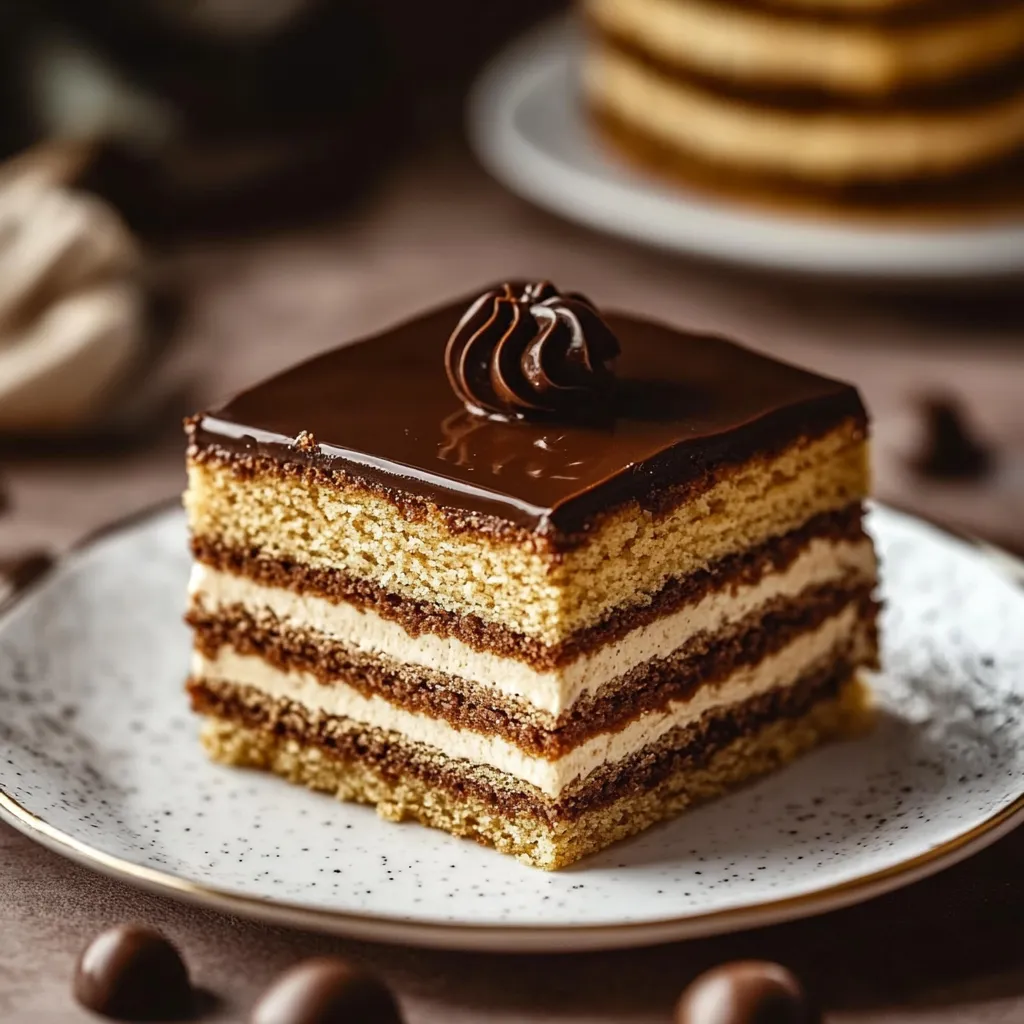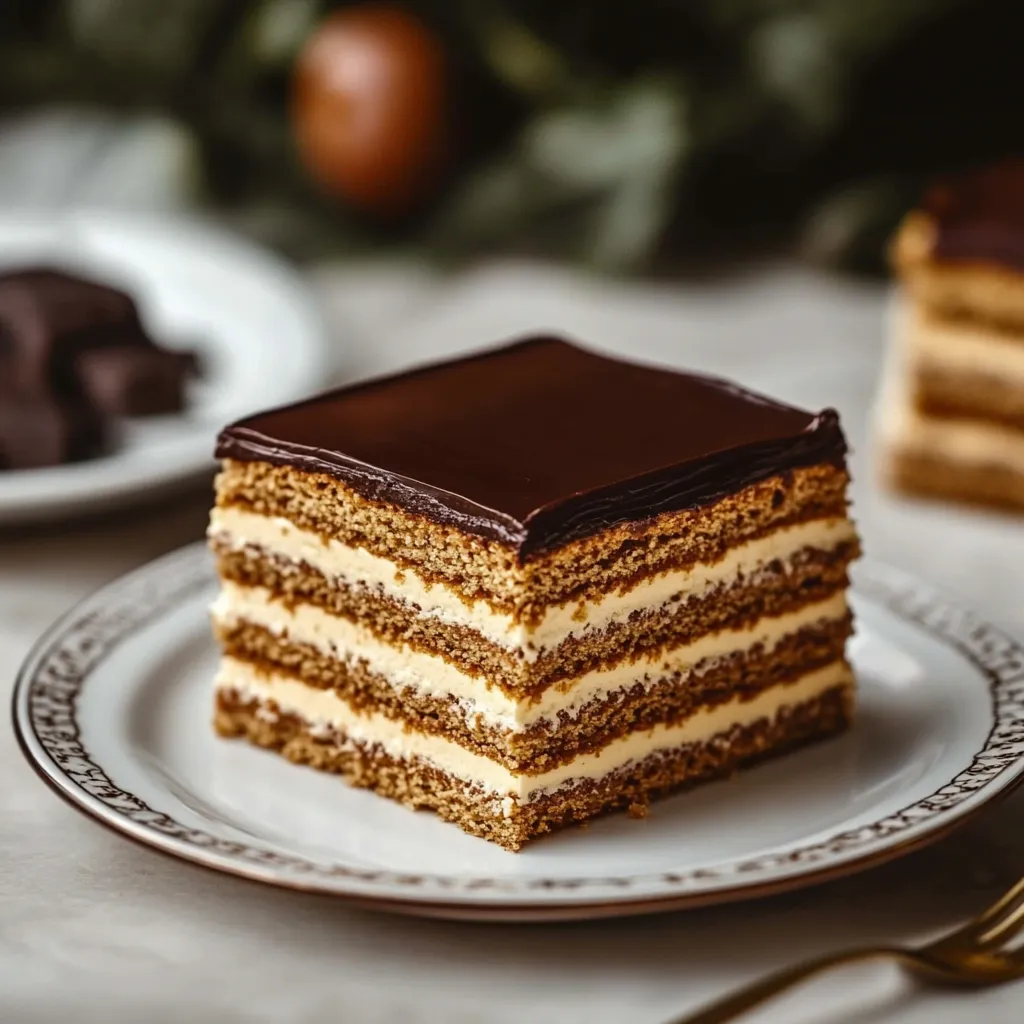 Bookmark
Bookmark
This elegant Opera Cake transforms any gathering into a special occasion with its sophisticated layers of almond sponge, coffee-infused ganache, and silky buttercream. The classic French patisserie creation brings together rich chocolate and coffee notes in perfect harmony.
I first attempted this Opera Cake for my husband's birthday after we returned from Paris. Though initially intimidated by its reputation, the methodical layering process became almost meditative, and now it's my go-to impressive dessert for celebrations.
Ingredients
- Joconde Almond Sponge Cake
- 5 eggs at room temperature crucial for proper volume and structure
- 5 oz ground almonds provides the distinctive nutty flavor and unique texture
- 5 oz powdered sugar creates tenderness in the delicate sponge layers
- 1/4 cup flour just enough to provide structure without heaviness
- 2 tbsp melted butter adds richness and prevents dryness
- Coffee Ganache
- 8 oz dark chocolate choose quality chocolate with 60 to 70% cocoa for best flavor
- Half Cup Heavy cream creates the perfect silky ganache consistency
- 1 tbsp coffee liqueur optional but enhances the coffee notes beautifully
- Coffee Buttercream
- 1 Cup unsalted butter softened butter creates the perfect creamy base
- 2 cup powdered sugar provides structure and sweetness without graininess
- 1/4 cup brewed coffee use strong coffee for pronounced flavor
- Additional Components
- Chocolate glaze for decoration adds shine and completes the professional look
- Coffee syrup or brewed coffee essential for moisture and flavor infusion
Step-by-Step Instructions
- Prepare The Oven And Pan
- Heat your oven to a hot 425°F. This high temperature ensures quick baking that keeps the sponge light. Line your baking sheet meticulously with parchment to guarantee easy release of the delicate sponge.
- Create The Joconde Sponge
- Beat the eggs and powdered sugar vigorously until the mixture becomes notably pale and doubles in volume. This air incorporation is essential for the proper texture. Carefully fold in both flours using a gentle cutting motion to maintain airiness. Finally incorporate the melted butter with minimal stirring to preserve the structure.
- Bake The Sponge Layer
- Spread the batter with precision onto your prepared baking sheet creating an even layer about 1/4 inch thick. Watch carefully as it bakes for 8 to 10 minutes. The perfect Joconde will be lightly golden with a slight spring when touched. Allow to cool completely before handling to prevent tearing.
- Prepare Coffee Ganache
- Bring heavy cream just to a simmer watching carefully to prevent boiling over. Pour immediately over the chopped chocolate ensuring all pieces are submerged. Practice patience allowing the mixture to sit undisturbed for 2 minutes before stirring. When you begin stirring start from the center working outward until gloriously smooth. Add coffee liqueur after fully combined for best flavor integration.
- Make Coffee Buttercream
- Beat softened butter for a full 3 minutes until noticeably lighter in color and texture. Add powdered sugar gradually in small portions to prevent a messy cloud. Incorporate the cooled coffee slowly creating a silky emulsion. Continue beating for 5 minutes to achieve the perfect light texture.
- Assemble The Cake
- Begin with a layer of Joconde in your rectangular mold brushing generously with coffee syrup until moist but not soggy. Apply ganache in an even layer followed by buttercream creating clean distinct layers. Repeat the layering process finishing with a final sponge layer on top. Press gently to ensure layers bond without squeezing filling out the sides.
- Glaze And Finish
- Pour slightly cooled chocolate glaze over the top creating a mirror like finish. Refrigerate for at least 4 hours preferably overnight to allow flavors to meld and layers to set properly. Cut with a hot knife for clean professional edges.
 Bookmark
Bookmark
The coffee component in this recipe is what truly elevates it from ordinary layer cake to extraordinary dessert. I discovered that using freshly brewed espresso rather than instant coffee creates a profound depth that reminds me of the first Opera Cake I tasted in a tiny Paris patisserie. My grandmother once told me great desserts should whisper rather than shout their flavors, and this cake exemplifies that philosophy perfectly.
The Perfect Slice
Achieving clean slices requires patience and technique. After chilling the cake thoroughly, warm your knife under hot water and wipe dry before each cut. Move the knife in one smooth direction rather than sawing. This creates the distinctive layered appearance that makes Opera Cake instantly recognizable. Allow slices to come to room temperature for about 15 minutes before serving to experience the full flavor profile.
Storage Wisdom
Opera Cake actually improves with a day of rest in the refrigerator. Store it covered but not airtight to prevent condensation from damaging the glaze. The cake keeps beautifully for up to 5 days refrigerated. For longer storage, individual slices can be frozen with parchment between layers. When ready to serve frozen slices, thaw in the refrigerator overnight rather than at room temperature for best texture preservation.
Historical Notes
This elegant dessert was reportedly created in the 1950s by French pastry chef Cyriaque Gavillon at the renowned Dalloyau patisserie in Paris. The name "Opera" was chosen because the cake resembles the layers and sophistication of the Paris Opera House. Traditionally, each slice would be marked with the word "Opera" in chocolate script. The classic proportions call for precisely seven layers, representing the seven notes in a musical scale.
Recipe FAQs
- → How long does Opera Cake need to chill before serving?
Opera Cake should be chilled for at least 4-6 hours before serving, though overnight refrigeration is ideal. This allows the layers to set properly and the flavors to meld together, resulting in the classic firm texture and enhanced taste.
- → Can I make Opera Cake in advance?
Yes, Opera Cake is perfect for making ahead! It can be prepared 1-2 days in advance and kept refrigerated. In fact, many pastry chefs prefer making it a day ahead as the flavors develop and intensify with time.
- → What can I substitute for coffee liqueur?
If you prefer not to use coffee liqueur, you can substitute with strong brewed coffee with a bit of sugar dissolved in it, or coffee extract mixed with a little simple syrup. For a non-caffeinated version, consider using hazelnut or almond extract for complementary flavor.
- → Why is my Opera Cake soggy?
A soggy Opera Cake usually results from over-soaking the sponge layers with coffee syrup. Apply the syrup with a light hand using a pastry brush. Also, ensure your buttercream and ganache have proper consistency and are not too warm when assembling the cake.
- → What's the traditional shape and size for Opera Cake?
Traditional Opera Cake is rectangular with clean, precise edges. It's typically about 1 inch (2.5cm) tall with multiple thin layers visible from the side. When served in pastry shops, it's often cut into rectangular portions about 2x4 inches (5x10cm) to showcase the beautiful layering.
- → How do I achieve perfectly even layers?
For even layers, use a frame or rectangular mold during assembly. Spread each component with an offset spatula to ensure uniform thickness. Refrigerate between adding layers if needed to maintain stability. A serrated knife dipped in hot water makes clean cuts when serving.
